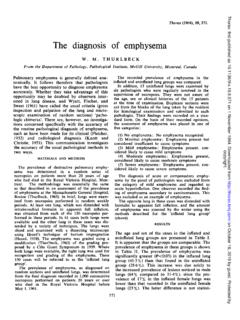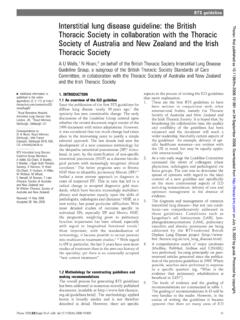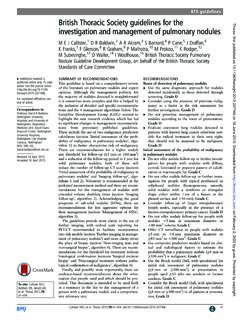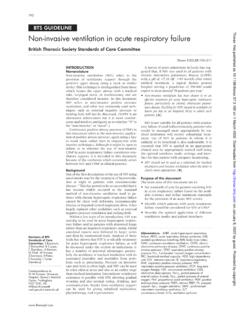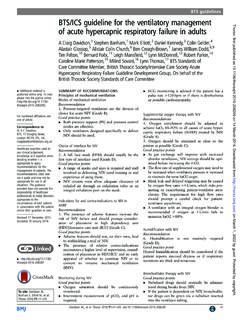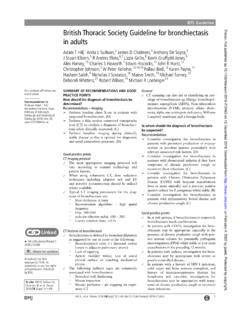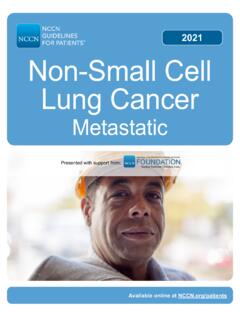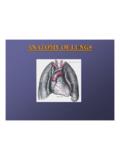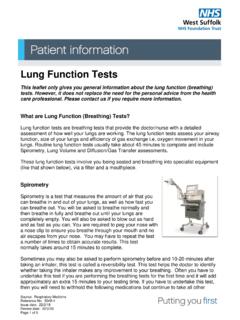Transcription of An update on contraindications for lung function testing
1 An update on contraindications for lungfunction testingBrendan G CooperABSTRACTG uidelines on contraindications for lung function testshave been based on expert opinion from>30 years contraindications to lung function testing areassociated with cardiovascular complications such asmyocardial infarct, pulmonary embolism or ascendingaortic aneurysm. Slightly less risky but still seriouscontraindications are predominantly centred on recoveryfrom major thoracic, abdominal or head surgery. Lessserious surgical procedures will present a possible risk,but the RR depends upon whether the lung function isessential or can wait until the patient s conditionimproves.
2 In recent decades there have been movestowards less invasive surgical techniques, keyholesurgery and new technology such as laser surgery whichminimise the amount of collateral damage to surroundingtissues. In thoracic surgery there is a shift in emphasis toquicker postsurgical mobility. Furthermore there hasbeen little analysis of the scientific facts behind thecurrent recommendations and contraindications . Theprinciple absolute and relative contraindications are inneed of revision, and recommended times of abstainingfrom lung function tests needs to be reviewed.
3 Thisreview aims to outline the key issues and suggestsnewer recommendations for contraindications forperforming lung function using a risk matrix, as well asoffering alternative approaches to testing patients whomay be at risk of complication from testing . In general,the previous recommendation of waiting for 6 weeksafter surgical procedures or medical complications beforeperforming lung function can often now be reduced to<3 weeks with modern less invasive lung function testing , and particularly spirom-etry, becomes more widespread across primary andsecondary, care there are greater numbers of prac-titioners and commissioners who are unaware ofthe potential harm and discomfort that these testscan cause to some patients.
4 International guidelineson contraindications for lung function tests1havebeen cited by many sources23but their evidencebase is generally from the USA and is founded onlyon expert opinion which is now>30 years developments in surgical practice andtechnology have decreased the invasive nature ofprocedures, so some of the contraindications maynow need paper aims to review the evidence base forthesecontraindications and, where it is lacking,examine the known facts around the potentialproblems in order to suggest new recommenda-tions.
5 In the current culture of evidence-basedmedicine, this is a timely and worthwhile reviewthat needs wide dissemination and discussion inorder to formulate new generally fall under theumbrella of risk management and clinical gover-nance issues in most health centres. Risk manage-ment is made up of two components (1) thelikelihood of the event happening and (2) theseverity of the consequences for the patient if ithappens. In most areas of respiratory physiologytesting, the likelihood of an adverse event is verylow and many often have relatively minor (non-life-threatening) consequences (eg, cataractdetachment during spirometry).
6 Even the moreserious surgical complications such as rupture of anaortic aneurysm which has an absolute prevalenceof only in men and in women8arerelatively rare, so the likelihood of these happeningduring spirometry is very rare. Postponed lungfunction testing due to current contraindications inour experience is (personalcommunication, ARTP website Forum 2009). Asuggested table of relative risks appears inappendix can be considered as being relative or absolute .Most contraindications arerelative and require the requesting physician/healthcare expert to judge when it is safe andappropriate to undertake the breathing test.
7 Abso-lute contraindications are those that would causetrauma, injury or death to the patient if they wereundertaken. Sometimes the contraindication justmeans that the test is unnecessary or unlikely to beof real clinical benefit to a compromised patient,and a lung function test would be better when theyare remote from surgery or infection. Similarly,a dogmatic approach of refusal to test patients withany contraindication needs to be main principle of performing lung functiontests is that the risks of the procedure will provideinformation that will be outweighed by the benefitthe patient s assessment for operation or treatmentprovides.
8 If the reverse is true and the lung functiontest does not entail any benefit for the level of risksustained, then the test should not be liaison between surgical staff, medical staffand healthcare scientists/technologists in lungfunction should eradicate most unnecessary risk key relative contraindications cited by the1996 American Association for Respiratory Care(AARC) documents1are:<Haemoptysis of unknown origin (forced expira-tory manoeuvre may aggravate the underlyingcondition);<Pneumothorax;Corre spondence toBrendan G Cooper, LungInvestigation Unit, UniversityHospitals Birmingham NHSF oundation Trust, Edgbaston,Birmingham B10 2TH, 31 March 2010 Accepted 11 May 2010 Published Online First29 July 2010714 Thorax2011;66:714e723.
9 On April 18, 2022 by guest. Protected by : first published as on 29 July 2010. Downloaded from <Unstable cardiovascular status (forced expiratory manoeuvremay worsen angina or cause changes in blood pressure) or recent myocardial infarction or pulmonary embolus;<Thoracic, abdominal or cerebral aneurysms (danger of rupturedue to increased thoracic pressure);< Recent eye surgery (eg, cataract);<Presence of an acute illness or symptom that might interferewith test performance (eg, nausea, vomiting); and<Recent thoracic or abdominal recommendations are based on very little to date there have been no randomisedcontrolled trials (RCTs) published in this area.
10 Each of these keyissues will be reviewed in this paper and, where possible, newrecommendations will be HARM FROM LUNG function TESTSThe most likely harm from lung function testing originatesprobably from four key factors:1. Maximal pressures generated in the thorax and their impactonabdominal and thoracic Large swings in blood pressure causing stresses on tissues inthe body (head, limbs, etc.).3. Expansion of the chest wall and Active communicable diseases (tuberculosis (TB), hepatitis B,HIV, etc.).It is worth noting that postoperative physiotherapy includingencouragingdeep breathing, coughing and incentive spirometryafter thoracic surgery is actually thought to be beneficial interms of reversing atelectasis, thus reducing the risk of in cardiothoracic surgery the emphasis isnow shifting towards earlier mobilisation of the patient post-operatively in order to re-establish normal respiration ratherthan a policy of avoiding contraindications have a higher risk.
